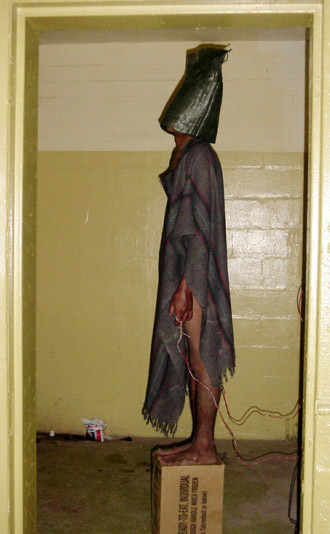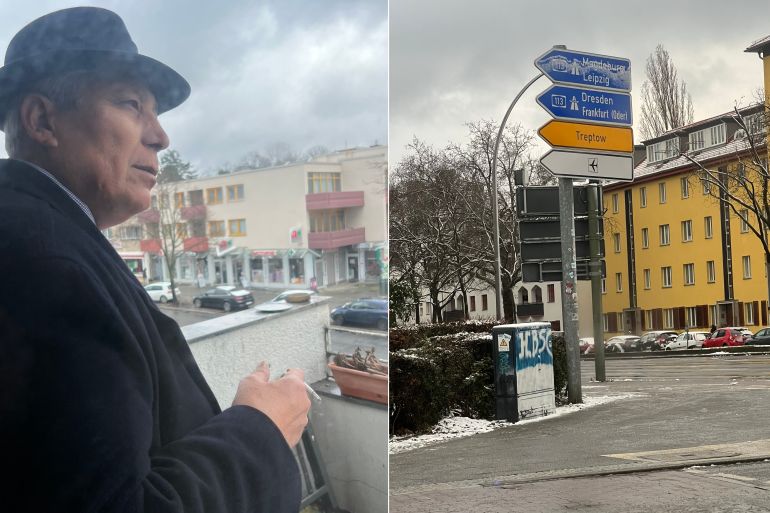Abu Ghraib Survivor: Taking the Hood Off 20 Years After Iraq War
A former detainee at the notorious Abu Ghraib prison in Iraq recounts the horror and pain of his incarceration two decades after the war.

All Global Research articles can be read in 51 languages by activating the Translate This Article button below the author’s name.
To receive Global Research’s Daily Newsletter (selected articles), click here.
Follow us on Instagram and Twitter and subscribe to our Telegram Channel. Feel free to repost and share widely Global Research articles.
***
It was snowing and the roads were empty on an early Saturday. The dread was, is it really him? Will he agree to speak?
We arrived at his apartment and were greeted by a friend who took us up. He introduces himself in smart attire. Meet Ali Shallal al-Qaysi, the man under the hood of the torture photos from the infamous Abu Ghraib prison.
He takes me to the kitchen and whispers as we set up for the TV interview in the other room – some details are too gruesome and painful to recount. I assure him, it is his story and I will listen to what he has to tell us. What ensues in the next couple of hours is not for the faint-hearted. His stories paint a horrific picture of inhumane abuse, humiliation, torture and sadistic behaviour.
Al Jazeera TV Interview of Ali Shallal
“I was standing on the box. It is so strong, not breakable. They tied wires and started electrical shocks. I remember biting my tongue, my eyes felt they were about to pop out. I started bleeding from under the mask and I fell down,” says Ali.
Despite his hand losing complete function because of the torture, Ali likes to paint in his spare time. His apartment is full of canvases. One stands out – a hood, orange jumpsuit, and handcuffs with 151716 painted on it, Ali’s prisoner number. He says they wrote “Big Fish” with a marker on his forehead, a common practice of “marking” high-profile prisoners.
‘A top secret place’
Without prison records, we cannot verify he is the man under the hood. But with testimony from two decades ago, his deformed hand that earned him the nickname “the claw”, his photos, court cases, and interviews with former prison officials and lawyers, it is clear Ali was among the victims at Abu Ghraib.
Ali was kept for months, between 2003 and 2004, at the prison. At one point after his torture, he says, he lost track of time for weeks as he was left in the tents where prisoners were held.
Abu Ghraib was feared from the time of Saddam Hussein, who built torture chambers there. After the 2003 US-led invasion, US contractors built more cells equipped with deadbolts.
Now-demoted, General Janis Karpinski was commander of Abu Ghraib prison when the abuse scandal erupted. She told Al Jazeera she was unaware of the torture between May and September 2003 when she was in charge of the prison.
“There was a central wing which served as the cafeteria. On the left were cell blocks 1A and B, 2A and B … and on the right, the last building which was not damaged in the [air] strikes. This became a top-secret place. The last cell block was where Pappas [Colonel Thomas Pappas, who was in charge of Abu Ghraib prison’s intelligence unit] had his satellites and his men were stationed. They had a direct line to [Defense Secretary Donald] Rumsfeld there. They did interrogations there. Females were kept over at the airport facility. There may have been a few in Abu Ghraib,” says Karpinski.
Female ‘hostages’
Ali wells up when he describes the screams of women kept on the other side of his cell block. “Women were put on the sector to our left on the second floor. We heard their cries. The guards used to get a male detainee to serve them food but on one condition, he should serve them food while he is fully naked. We were all kept naked by the way. We used to hear their screams, there was a guy called Fredrik who used to harm them.”
Ali broke down at this point, sobbing. “We could not help them, we could not do anything for them. Some of us were banging heads against the wall, we do not want this to happen again and again. Occupation is the worst shape of terrorism, crushes the dignity of people and destroys countries. It was not easy to hear these women cry. They did nothing, they were brought as hostages. When [the Americans] carry out a raid against a former regime official or a nuclear scientist and fail to detain the wanted man, they brought women as hostages.
“We heard them crying and screaming what they have been going through. I have witnessed a horrible scene – a man had his wife raped before his eyes.”
Human rights groups have documented beatings, prolonged sleep and sensory depravation, and detainees being held naked and tortured.

Ali Shallal al-Qaysi at his apartment in Berlin, Germany [Osama Bin Javaid/Al Jazeera]
‘They were sadists’
The images – taken and released by an American soldier – shocked the world with their sheer brutality. The most explicit photographs depict nudity, degradation, simulated sex acts, and American guards posing with decaying corpses. After an international outcry, 11 US soldiers were convicted, but others were reprimanded without any charges.
“Abu Ghraib, Camp Bucca and other torture sites lowered the bar for adherence to the Geneva Conventions and other international obligations to treat prisoners humanely,” says Letta Tayler from Human Rights Watch.
“Ironically, one of the many flimsy justifications made by President George W Bush to invade Iraq was that Iraqi leader Saddam Hussein would aid terrorists. Yet it was the US-led invasion that created a security vacuum and fueled grievances that enabled the rise of al-Qaeda in Iraq, which morphed into ISIS [ISIL], prompting yet more cycles of violence.
“All US presidents since George W Bush, who started the Iraq war, have refused to prosecute any of the architects of the war crimes committed during the Iraq war. For example, no ranking official has been prosecuted for the horrors inflicted on detainees at Abu Ghraib, only lower-level military personnel who in most cases received negligible sentences. Most civilians never received any funding or other amends for deaths, injuries, or property damage by US forces, much less apologies.”
Ali says the pictures only reflect a fraction of the abuse that took place after the invasion.
“Abu Ghraib prison was one out of 75 other sites used as detention centres with these violations. What kind of human being can do such things? To force people to be naked, sexually humiliated, inserting broken wood sticks in sensitive parts until they bleed, electric shock to genitals. I remember one man … he died before our eyes while he was tortured. They were sadists.”
When we asked about the infamous dog photos, Ali replies, “I was humiliated, I was mauled by a dog right here”, pointing to a bite scar on his neck. “I was naked in the cell. You know there was no bed. They meant to harm us by bringing the dog into the cell.”
Ali says he has dedicated his life to seeking justice from the architects of the abuse. His lawyer Andreas Schüller works for the European Center for Constitutional and Human Rights (ECCHR).
“It’s a very clear-cut case of torture in prison under the military occupation by the US, but on the other hand you can also show the chain of command in setting up the prison system, the mistreatment of prisoners in Iraq by the US military. And this goes all up to Donald Rumsfeld,” Schüller says.
Ali’s lawyers say German authorities should have done much more since the case was filed in 2015. ECCHR requested the prosecutor to secure evidence and take testimonies of survivors and experts. Schüller says German federal prosecutors have not pursued Ali’s case as they did previous ones.
“There are political reasons not to do that, to go against an ally against the United States. Even 20 years after the invasion of Iraq, it’s a constant topic. You saw it in 2003 with the US-UK-led invasion of Iraq and now see it with Russia in Ukraine. And as long as it’s not punished, the risk is that we see it again in different constellations,” says Schüller.
Back in Ali’s apartment, I asked, “Why did they call you the claw at Abu Ghraib?”
“This happened when they hanged me on the wall. Because of the weight of my body, the handcuff was piercing my hand. The wound was almost rotten,” he says.
So were the hangings and electrocutions the worst of the torture?
“Another way of torture was music. It is worse than physical torture. They force you [to] lie on your stomach on the ground, all tied up. And they bring big speakers thumping with an unbearably loud noise placed on either side of your head. I remember the song they played called Babylon, Babylon, even when they turned off the speakers, it kept ringing in my ears.”
Ali’s ordeal ended when he was taken in a truck and released on a highway away from Abu Ghraib with dozens of other prisoners. He was never charged with a crime.
As he waits for justice, Ali refuses to let the world forget his story. He says his worst nightmare is if people do not remember and it happens again to others in another war.
Although his lawyer is not hopeful that Ali will see justice in his lifetime, he is adamant to carry on.
“I think even after 1,000 years, our great grandsons will receive our rights. The world is changing and people who were tortured in Vietnam and other places, they are getting their rights … Even for those who were tortured by the Nazis or by Stalin, Hitler and others, now they are getting their rights,” says Ali.
*
Note to readers: Please click the share buttons above. Follow us on Instagram and Twitter and subscribe to our Telegram Channel. Feel free to repost and share widely Global Research articles.
Featured image: This handout photo from SBS TV received 15 February, 2006 shows a hooded prisoner allegedly being tortured at Iraq’s notorious Abu Ghraib jail supposely during interrogation by US soldiers in Baghdad in 2004. Australian public broadcaster SBS 15 February released a handful of what it said were previously unpublished photographs of the abuse of prisoners in Iraq’s notorious Abu Ghraib jail by US soldiers. RESTRICTED TO EDITORIAL USE AFP PHOTO/HO/SBS DATELINE

